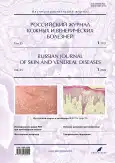The effectiveness of the IL-17A inhibitor in generalized pustular psoriasis: a clinical case
- 作者: Olisova O.Y.1, Snarskaya E.S.1, Kochergin N.G.1, Teplyuk N.P.1, Ignatyev D.V.1, Tavitova A.R.1, Makhmudi W.1
-
隶属关系:
- I.M. Sechenov First Moscow State Medical University (Sechenov University)
- 期: 卷 25, 编号 1 (2022)
- 页面: 73-83
- 栏目: DERMATOLOGY
- URL: https://journal-vniispk.ru/1560-9588/article/view/105295
- DOI: https://doi.org/10.17816/dv105295
- ID: 105295
如何引用文章
详细
The first clinical case of the effective use of a domestic biological drug inhibitor netakimab ― IL-17A ― in a patient with persistently progressive, torpid to therapy generalized pustular psoriasis Tsumbush is presented. This rare systemic dermatosis refers to severe forms of psoriasis that threaten the patient’s life and require intensive therapy from the very first hours of the manifestation of the disease. The development of pustular psoriasis can be promoted by: long-term therapy with systemic glucocorticosteroids, cytostatics, oral contraceptives, as well as prolonged use of irritating external agents. In some cases, the disease is associated with high emotional stress, stress. In severe generalized pustular psoriasis, biological drugs, cyclosporine, methotrexate, and acitretin are effective.
The article presents summary data on the effectiveness of first- and second-line drugs in the treatment of pustular psoriasis. According to the literature, patients with severe pustular psoriasis, torpid to standard therapy, demonstrate a positive response to treatment with biological drugs in most cases. Anti-TNF-α are the most available biological drugs for the treatment of pustular psoriasis, and anti-IL-12/23 and anti-IL-17A can be considered as the first or second line of therapy for moderate-severe and refractory pustular psoriasis.
The choice of effective therapy for the treatment of pustular psoriasis is an urgent problem of modern dermatology and the presented clinical case demonstrates the effectiveness and pronounced positive therapeutic effect of the IL-17A inhibitor for 1 day in the treatment of generalized pustular psoriasis resistant to previously conducted therapy, which allows us to count on the prospect of further successful use of this targeted drug in the treatment of severe pustular psoriasis.
作者简介
Olga Olisova
I.M. Sechenov First Moscow State Medical University (Sechenov University)
编辑信件的主要联系方式.
Email: Olisovaolga@mail.ru
ORCID iD: 0000-0003-2482-1754
SPIN 代码: 2500-7989
MD, Dr. Sci. (Med.), Professor
俄罗斯联邦, MoscowElena Snarskaya
I.M. Sechenov First Moscow State Medical University (Sechenov University)
Email: snarskaya-dok@mail.ru
ORCID iD: 0000-0002-7968-7663
SPIN 代码: 3785-7859
MD, Dr. Sci. (Med.), Professor
俄罗斯联邦, MoscowNikolay Kochergin
I.M. Sechenov First Moscow State Medical University (Sechenov University)
Email: nkocha@yandex.ru
ORCID iD: 0000-0001-7136-4053
SPIN 代码: 1403-3031
MD, Dr. Sci. (Med.), Professor
俄罗斯联邦, MoscowNatalia Teplyuk
I.M. Sechenov First Moscow State Medical University (Sechenov University)
Email: teplyukn@gmail.com
ORCID iD: 0000-0002-5800-4800
SPIN 代码: 8013-3256
MD, Dr. Sci. (Med.), Professor
俄罗斯联邦, MoscowDmitry Ignatyev
I.M. Sechenov First Moscow State Medical University (Sechenov University)
Email: dmitrywork@list.ru
ORCID iD: 0000-0001-8751-3965
SPIN 代码: 6743-7960
俄罗斯联邦, Moscow
Alana Tavitova
I.M. Sechenov First Moscow State Medical University (Sechenov University)
Email: alatavitova@mail.ru
ORCID iD: 0000-0003-1930-0073
SPIN 代码: 2113-9091
Graduate Student
俄罗斯联邦, MoscowWilliam Makhmudi
I.M. Sechenov First Moscow State Medical University (Sechenov University)
Email: dr.williamm@mail.ru
ORCID iD: 0000-0001-6075-411X
俄罗斯联邦, Moscow
参考
- Crowley JJ, Pariser DM, Yamauchi PS. A brief guide to pustular psoriasis for primary care providers. Postgrad Med. 2021;133(3): 330–344. doi: 10.1080/00325481.2020.1831315
- Olisova OY, Khobeish MM, Znamenskaya LF, Bakulev AL. Federal clinical guidelines for the management of patients with psoriasis. Moscow; 2013. 68 р. (In Russ).
- Olisova OY, Teplyuk NP, Pinegin VB. Modern methods of psoriasis treatment. Russ Med J. 2015;23(9):483–484. (In Russ).
- Boehner A, Navarini AA, Eyerich K. Generalized pustular psoriasis is a model disease for specific targeted immunotherapy, a systematic review. Exp Dermatol. 2018;27(10):1067–1077. doi: 10.1111/exd.13699
- Johnston A, Xing X, Wolterink L, et al. IL-1 and IL-36 are dominant cytokines in generalized pustular psoriasis. J Allergy Clin Immunol. 2017;140(1):109–120. doi: 10.1016/j.jaci.2016.08.056
- Hoegler KM, John AM, Handler MZ, Schwartz RA. Generalized pustular psoriasis: a review and update on treatment. J Eur Acad Dermatol Venereol. 2018;32(10):1645–1651. doi: 10.1111/jdv.14949
- Wang WM, Jin HZ. Biologics in the treatment of pustular psoriasis. Expert Opin Drug Saf. 2020;19(8):969–980. doi: 10.1080/14740338.2020.1785427
- Genovese G, Moltrasio C, Cassano N, et al. Pustular psoriasis: from pathophysiology to treatment. Biomedicines. 2021;9(12):1746. doi: 10.3390/biomedicines9121746
- Gooderham MJ, van Voorhees AS, Lebwohl MG. An update on generalized pustular psoriasis. Expert Rev Clin Immunol. 2019;15(9):907–919. doi: 10.1080/1744666X.2019.1648209
- Ratnarajah K, Jfri A, Litvinov IV, Netchiporouk E. Spesolimab: a novel treatment for pustular psoriasis. J Cutan Med Surg. 2020;24(2):199–200. doi: 10.1177/1203475419888862
- Komine M, Morita A. Generalized pustular psoriasis: current management status and unmet medical needs in Japan. Expert Rev Clin Immunol. 2021;17(9):1015–1027. doi: 10.1080/1744666X.2021.1961580
补充文件










